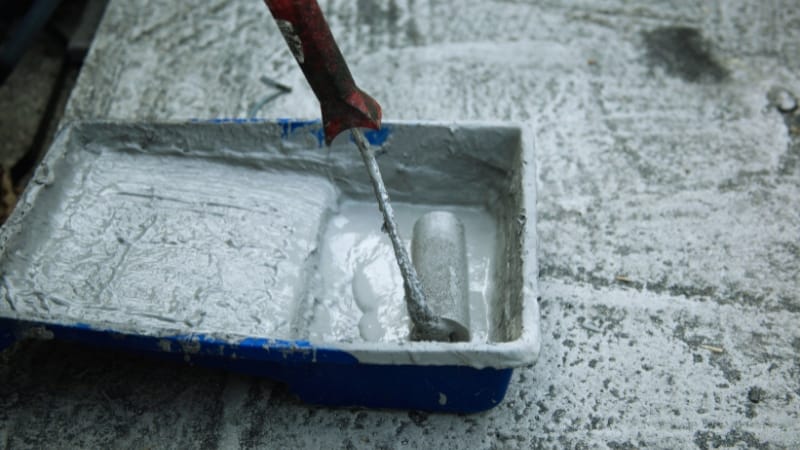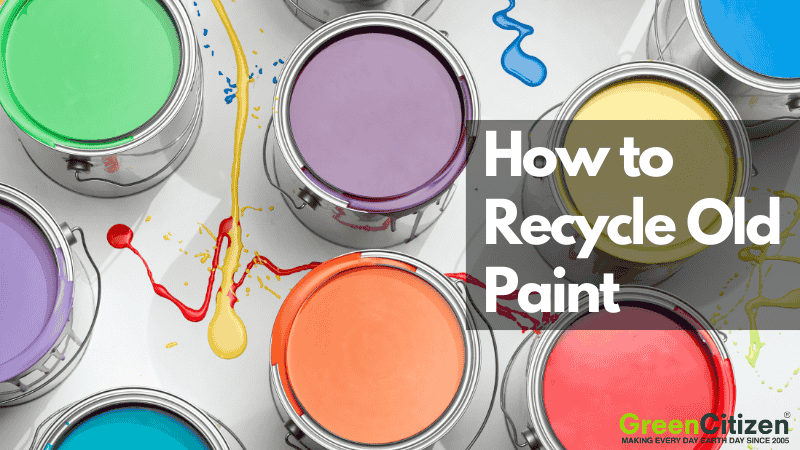If you’ve ever finished a home painting project, you know the drill: the leftover paint cans. What do you do with them? I used to stack mine in the garage, thinking they’d come in handy. Fast forward a few years, and I had a rainbow of half-empty cans taking up space. That’s when I realized I had no clue how to recycle old paint.
It turns out, you can’t just toss it in the trash. Paint is considered hazardous waste in many places, and improper disposal can harm the environment. But don’t worry! There are simple, eco-friendly ways to handle your old paint.
Keep reading as we’ll discuss the best methods for responsibly reusing or recycling old paint. Whether it’s latex or oil-based, there’s a way to give it a second life without cluttering your garage—or the planet.
Can You Throw Paint in The Trash?

No, you can’t throw paint in the trash or dump it down a drain. Paint can have a harmful impact on the environment and even affect people’s health if not properly handled and recycled.
There are two kinds of paint: oil and latex (these differ by their base liquid). Latex-based paint isn’t harmful, but it needs to be properly handled.
Oil-based paints are flammable, hazardous, and have a large amount of volatile organic compounds (VOCs) that cause air pollution. VOCs release harmful fumes into the air, which leads to air pollution if not disposed of properly. Moreover, toxic components of oil-based paints can seep into the ground and contaminate groundwater.
Paint can even lead to health issues.
You know that new paint smell?
Well, it can be very harmful to you. As the paint dries, the ingredients that keep it liquid evaporate and release fumes that contain VOCs. Most common VOCs include ethanol, styrene, acetone, glycol ethers, formaldehyde, and many other toxic chemicals.
These chemicals can lead to serious health issues, such as liver and kidney damage, cancer, and damaged nervous system.
If you were to throw oil-based paint into the trash, it would negatively affect the waste management system. The toxins from the paint can leach out and damage landfill liners, cause groundwater pollution, and the chemicals can mix and react with other materials in the waste and create harmful byproducts.
Overall, both latex and oil-based paint should be recycled, but this is even more important for oil-based paints. You need to use proper disposal methods and take the paint to designated collection centers or recycling programs to prevent damage to the environment and protect human health.
How to Recycle Latex Paint?

Recycling latex paint is easier and less dangerous compared to oil-based paint. Latex paint is water-based and doesn’t have as many toxins, which means it’s not as harmful to the environment and humans. However, it still needs to be properly disposed of.
If you have usable, leftover latex paint, you can donate it to community organizations, schools, or friends and family. This reduces waste, and others can benefit from your leftover paint.
Here’s how to determine if latex paint can be used:
- Check the smell — If the paint smells rancid, it’s gone bad and can’t be donated.
- Check if it’s separated — Paint usually has thin skin on top and a liquid layer underneath. Remove the skin and stir the paint with a paint stick. If the paint isn’t hard on the sides or the bottom, it’s still good.
However, if your latex paint isn’t usable or has dried out, you should recycle it. Here’s how to recycle latex paint step-by-step:
- Check local regulations — Some municipalities have specific instructions and rules for recycling paint. You can contact your local waste management program and ask about guidelines for paint disposal.
- Solidify the paint — If you only have a small amount of paint left over, it’s best to solidify it. Remove the lid and let the paint dry. You can also add an absorbent material to speed up the process. Use cat litter, paint hardener, or sawdust.
- Dispose of the paint — Once the latex paint has dried, you can dispose of it with your regular household trash. The lid should be securely fastened.
Overall, latex paint isn’t considered hazardous, but its disposal can be costly, so many municipalities recommend alternative methods of disposing of paint, such as donating or reusing it.
How to Recycle Alkyd/Oil-based Paint?

Alkyd, or oil-based paints, are loved for their glossy, durable finish—perfect for furniture and cabinets. But when it comes to recycling, things get tricky because they contain toxic chemicals.
Here’s a step-by-step guide to recycling alkyd or oil-based paint:
- Check local regulations — Start by reaching out to your local waste management authority. Every area has different rules for recycling oil-based paint. Some places have special programs where the paint is repurposed into other coatings. There may also be scheduled collection events, or you might need to drop off your paint at a hazardous waste facility for energy recovery or testing.
- Follow transportation guidelines — Before you head to the recycling center, give them a call. They’ll provide instructions on how to prepare and transport the paint safely. Make sure to follow these guidelines to avoid any hiccups.
Recycling oil-based paint isn’t as straightforward as latex. Its chemical makeup makes it harder to repurpose, and the market for recycled oil-based paint is smaller.
Plus, federal regulations add extra hurdles. Always consult your local authorities to find the safest and most responsible way to recycle it in your area.
How to Recycle Aerosol Paint Cans?

Aerosol paint cans may seem harmless, but they’re filled with gaseous propellants and potentially hazardous materials. Tossing them in the trash? Bad idea. They can explode or leak chemicals, creating all kinds of dangerous situations.
To recycle them properly, you’ll need to check your local laws—different areas have different rules. Some aerosol cans even fall under the EPA’s Universal Waste Regulations, which means they must be disposed of following specific guidelines.
In some cases, you may need to remove plastic parts before recycling. Some places allow aerosol cans in curbside recycling, while others require you to drop them off at designated locations.
If your aerosol can is empty, good news! Empty cans are generally recyclable. Shake the can—if it’s completely silent, it’s empty. If you still hear liquid, spray it out. You can even take empty cans to a metal scrap yard, and if they’re made of aluminum or steel, you might get paid for them.
- Note: Don’t puncture an aerosol can to empty it because it can explode.
Aerosol cans with hazardous waste can’t be thrown out with regular waste. In fact, throwing them out with regular trash is illegal. Bring these cans to a collection site for hazardous waste, go to a hazardous waste collection event, or go to the hazardous waste facility. Contact your local government to check what’s the best procedure.
- Pro Tip: If you aren’t sure if your can has hazardous waste or not, check the symbols and labels on the can. If there’s a recycling symbol, the aerosol can most likely be recycled.
Where to Recycle Paint?

You can recycle paint with PaintCare. Paint Care is a nonprofit organization that has paint recycling programs in several US states, such as:
- California
- Colorado
- Connecticut
- The District of Columbia
- Maine
- Minnesota
- Rhode Island
- Vermont
- Washington
- New York
You can take your leftover paint to a PaintCare drop-off site. Most of these sites are paint retailers, which are open year-round, seven days a week.
Here’s how to recycle paint with PaintCare:
- Check eligibility — Go to the PaintCare website to check if your state participates in their program, as new states are added as paint stewardships are established in states.
- Gather all paint — Gather all paint you want to recycle. The paint should still be usable and not dried out or solidified.
- Find a drop-off location — Visit PaintCare website to find a drop-off location close to you. These can be retailers, home improvement stores, and other collection points.
- Prepare paint for drop-off — Secure the lid tightly for secure transportation. You can even place the paint cans in bags to prevent spillage.
- Drop off the paint — Bring your paint to the designated location and notify the staff you have paint for recycling.
PaintCare manages collected paint using various recycling processes. For example, they can remix usable paint, process it for other uses, or dispose of hazardous paint in an eco-friendly way.
If your state doesn’t have a PaintCare program, we’ve got you covered.
Use our Green Directory to find the paint recycling facility close to you. Enter paint recycling in the “search for” field, your address or zip code in the “location,” and hit search.

We’ll give you a list of all recycling centers in your area, complete with their address and phone number, so you can contact them and ask about paint recycling procedures.
How to Store Paint The Right Way?
Here’s how to store paint the right way step-by-step:
How to Seal It?
You must seal the paint properly to prevent air exposure. If the paint is exposed to air, it’ll dry up and spoil.
Pro tip: Use a rubber mallet and tap the lid down securely into place. You can even use a hammer, but make sure to gently tap or cover the can with wood and then use the hammer.
If your original lid is damaged or lost, you can transfer the paint to a clean, airtight container.
Where to Keep It?
Store paint in a cool, dry, and dark place. The basement is a good paint storage location, but make sure to place it on a shelf. You can also keep paint in cabinets or closets in your home.
Note: Temperature is also very important. Extreme hot or cold temperatures will ruin the paint. For example, cold temperatures cause latex paint to separate, and it becomes unusable. Heat dries it out and can even make oil-based paint trigger a fire.
Where Not to Keep It?
Don’t keep paint on the ground, but place it on a shelf, especially if you keep the paint in your garage or basement. Moisture from garage and basement floors can make the paint cans rust.
Note: Temperature is also very important. Extreme hot or cold temperatures will ruin the paint. For example, cold temperatures cause latex paint to separate, and it becomes unusable. Heat dries it out and can even make oil-based paint trigger a fire.
The Proper Way to Reopen the Cans
Be careful when opening a paint cap that’s been stored for a long time. It’s best to avoid a screwdriver because the lid can become warped. However, if you have to use a screwdriver, go for a flathead one and gently pry open the lid.
Some manufacturers give you a key specially made for opening paint cans. Don’t use a lot of force, or your risk damaging the lid.
How Long Can One Store the Paint Cans?
How long paint lasts depends on the type and storage conditions:
- Unopened latex paint can last up to 10 years.
- Unopened oil-based paint lasts 2–5 years.
- Opened latex paint should be used within 2–3 years.
- Opened oil-based paint is best within 1–2 years.
Properly stored paint can last a while, but always check the paint before use to ensure it’s still in good condition.
How to Know If Paint Went Bad?

Here’s how to know if your paint has gone bad:
- Check the smell — If your paint has a strong, strange smell, for example, foul or rancid, it’s a sign it’s gone bad. Fresh paint has a mild smell.
- Check the consistency — If your paint has noticeably thickened, turned lumpy, or has a curdled appearance, it’s gone bad. Fresh paint has a smooth, uniform consistency. Also, if there are separate paint layers, it’s another spoilage sign.
- Check for mold or mildew — In case there’s mold or mildew on the paint surface, it’s been contaminated. This usually happens in humid environments, especially if the paint was improperly sealed.
- Check the texture — If your paint has hardened into clumps or has a gritty texture, it’s spoiled. Fresh paint has a smooth and consistent texture.
- Check the color — If your paint has changed color, it’s another sign of spoilage. Some examples are fading, discoloration, and the presence of unusual particles.
Generally, oil-based paint isn’t as prone to spoiling as latex-based paint. As long as it’s properly sealed, it’ll stay good. But, if you notice any of the above signs, it’s best to dispose of the paint.
Using spoiled paint can lead to uneven coverage, bad application, and short durability. In other words, you’ll end up having to do more work to fix the bad paint job.
Should You Recycle Your Paint?
Absolutely! Recycling paint is crucial to protecting the environment and preventing pollution. Improper disposal can contaminate groundwater, contribute to air pollution, and even create fire hazards.
Check with your local government for the best recycling options in your area. This could include scheduled drop-off events, collection points, or taking paint to a hazardous waste facility.
Recycling takes minimal effort but has a huge impact on reducing environmental harm. Plus, just imagine how much cleaner and more organized your garage will be without all those old paint cans cluttering it up!
You can use our Green Directory to find the nearest paint recycling facility. Just enter “paint recycling” along with your address, and you’ll get a list of nearby recycling centers with their contact information.


